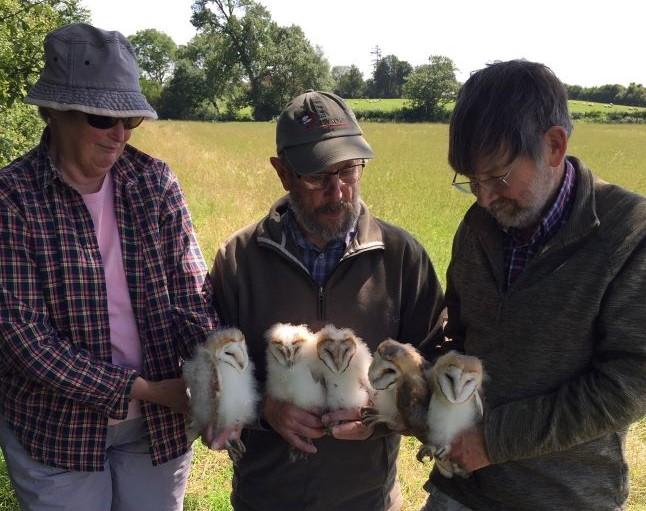
Ringing the changes in birds of prey
Changes in farming practices over recent decades have meant that the future of some species of birds of prey has become precarious. The Heart of England Forest aims to provide a habitat where they can thrive, and with the help of a remarkable trio of specialist volunteers, their progress is being closely monitored.
Our team
Undertaking the sensitive task of keeping a close eye on the Heart of England Forest’s birds of prey are husband and wife team John and Ros along with long-term pal Roger. Since 2012 they have been installing and checking the Forest’s growing network of nest boxes, ringing birds in order to observe their movements, measuring them and reporting on their breeding rates.
With new land being added to the Forest all the time, the workload for the team is always increasing as they erect new boxes, and plans are underway to train up a new volunteer to help lighten the load

Checking birds of prey nest boxes
Checking over 700 nest boxes across South Warwickshire, the trio submit all their results to the British Trust for Ornithology (BTO). Of these boxes, some 117 are situated in the Heart of England Forest with 49 barn owl boxes, 36 for kestrels, 29 for tawny owl and three for little owls. With different species breeding at varying times of the year, the trio’s schedule is almost always full on. They check tawny owl boxes throughout mid-April and May, kestrels in May and June and barn owls any time from the end of March until the end of September. In a good year the latter may produce more than one brood.
Checking the boxes can be a delicate assignment but Ros, John and Roger are seasoned professionals. Roger possesses the required BTO Schedule One Licence allowing him to monitor ban owls, and all three have a great deal of training and experience behind them. Always working on the assumption that there is a bird in the box, the team handle the young chicks with extreme caution, measuring them and placing rings on the legs of those over 30 days old.
It’s not always plain sailing of course, with other species such hornets or wasps sometimes commandeering the nest boxes or, as John chuckles, “sometimes we’ve got to watch out for a face full of squirrel!”
The food factor
While recent years have generally shown either a steady rise in bird of prey numbers or a level of consistency, 2018 was an exception. The unusually cold winter months combined with a scorching summer meant that vegetation struggled. As a result, the habitats for the small rodents and in particular the short-tailed field vole, a primary food source for the birds, were compromised. Where there is a scarcity of food, the birds automatically refrain from breeding.
Upturn in birds of prey numbers
Happily, the results so far from 2019 show an upturn in numbers across the Heart of England Forest. More clement weather has allowed the food source habitats to recover and rodent numbers to surge. Roger, John and Ros report that barn owl chicks numbering over 50 will mean that it could be their best year ever. Kestrel pairs stand at eight, approaching the 2016 record of 11, while 11 pairs of tawny owls have produced a near record 21 chicks.
The Local Biodiversity Action Plan designed to encourage birds of prey is showing impressive results, thanks in part to the Heart of England Forest. With the invaluable time and expertise of volunteers like Roger, John and Ros helping to examine the health of the Forest’s bird of prey population, work to ensure that these beautiful and precious birds continue to thrive here in the Forest remains well on target.
Become a valuable volunteer
If you’d like to learn more about the wildlife in the Forest and play a part in helping it to thrive, find out more about becoming a volunteer.



